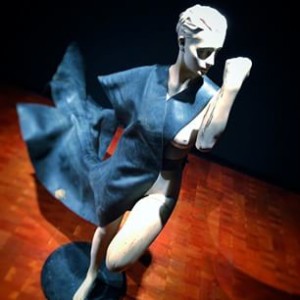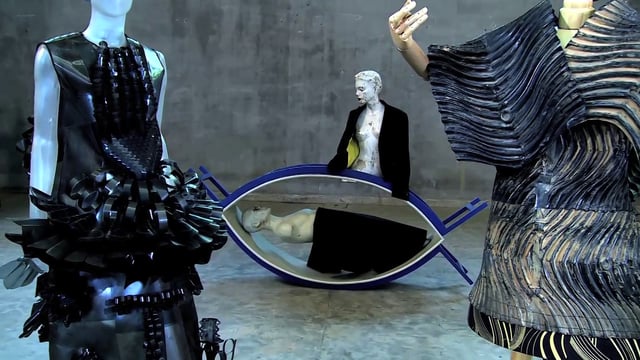The first encounter with the most strikingly original art (not unlike the most speculative scientific thinking) is always a bit strange – possibly configured, oriented or abstracted in a way toward which our minds and senses can only gradually accustom themselves. We become acclimated and reoriented, and then it starts to hit us; or maybe it just hits us straightaway and we turn our minds to reconstructing our perspectives, assumptions and expectations accordingly. This is not necessarily an experience exclusive to the speculative domain of the arts and sciences, though. The turbulence of these troubled times, reflected in a scan of the daily news headlines, continuously shakes our perspective of the world around us.
The New Delhi-based artist, Vivan Sundaram, is alive to this encounter in an almost immersive way – observing, collecting, comparing, juxtaposing, reconfiguring and reassembling from the imagery and actualities of a continuously morphing and fragmenting culture. You could almost say that his medium was the fragment – the fragmented image, the fragmented object. But it’s also about circulation – the way narratives, objects, images (and their fragments) circulate in the world. He is interested in reclaiming and recomposing from the debris, refuse, residue and cast-offs of our increasingly object- and and image-choked environment. Here his impulses and motives feed off pop culture and the obsolete, anachronistic, and waste materials of the medical-industrial sector. You could almost say he’s composing from the decomposed. 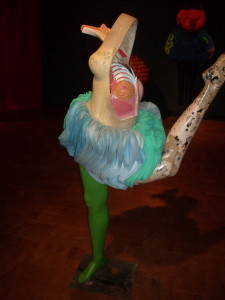
Making Strange encompasses two distinct but related bodies of work: Gagawaka and Post-Mortem. The notion of decomposition or dissection is crucial to both, but the sculpture-couture of Gagawaka positions itself in a living, moving world, transformed and transforming the environment it moves through. Sundaram’s art practice could be described essentially as assemblage (although in India, he is also known as an installation artist – and these are certainly examples of that genre, too). But where the body or (in varying ways) a mannequin is the principal support or armature, where the technique to one degree or another involves cutting and/or draping, we are talking about couture. Lady Gaga’s sometimes outlandish and frequently provocative costumes, maquillage, wigs and headgear were one inspiration (and there is at least one ‘assemblage-costume’ (“Tubing,” 2011) that Gaga could definitely rock with the right song and staging).
The ‘waka’ (even Sundaram’s titles are assemblages) comes from the 2010 FIFA World Cup official song, “Waka Waka” – and I’m not sure whether this is intended to reflect the global ‘beautiful game’ or a globalized cultural appropriation (there was some controversy over its particular ‘African’ spin; and Africa continues to be a locus for every variety of exploitation).
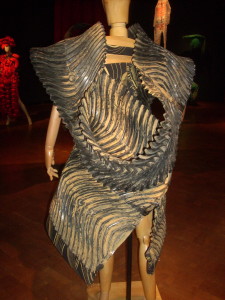 Sustainability is an issue in almost every industry, and no less so in the world of fashion at every level and price point. It’s not a little ironic that an industry devoted to sustaining human life generates an enormous amount of waste, some of it non-recyclable if not actually toxic. More to the physical, sculptural point here is the relationship of these materials with the human body. These are materials and devices that have direct and frequently intimate contact with the body: padding, surgical gauze, gowns, gloves, tubing, supports, splints, swabs, sponges and scrubbing materials, in cotton, synthetics, plastic, rubber, foam, and occasionally foils and metal (e.g., tablet/capsule packs for pharmaceuticals). One piece – the gauze “Pill/fill” suit – featured the pharmaceuticals themselves – here functioning as ‘paillettes’ or ‘beading’ (though I wondered if some of these might be at risk of staining the pale white, translucent gauze). There are also the materials that don’t have direct contact: films and X-rays – that nevertheless ‘externalize’ our skeleton and reveal internal organs and structures. This is also a show about the ‘inside-out’ – penetrating, exposing, sectioning the interior, and letting the external, the ‘outside’ in. These are works that variously deconstruct the idea and actuality of interpenetration, of circulation, vasculature. (I mean vasculature in the largest sense, encompassing the new shapes, volumes, corresponding geometries and functions that might correspond to such ‘vessels.’)
Sustainability is an issue in almost every industry, and no less so in the world of fashion at every level and price point. It’s not a little ironic that an industry devoted to sustaining human life generates an enormous amount of waste, some of it non-recyclable if not actually toxic. More to the physical, sculptural point here is the relationship of these materials with the human body. These are materials and devices that have direct and frequently intimate contact with the body: padding, surgical gauze, gowns, gloves, tubing, supports, splints, swabs, sponges and scrubbing materials, in cotton, synthetics, plastic, rubber, foam, and occasionally foils and metal (e.g., tablet/capsule packs for pharmaceuticals). One piece – the gauze “Pill/fill” suit – featured the pharmaceuticals themselves – here functioning as ‘paillettes’ or ‘beading’ (though I wondered if some of these might be at risk of staining the pale white, translucent gauze). There are also the materials that don’t have direct contact: films and X-rays – that nevertheless ‘externalize’ our skeleton and reveal internal organs and structures. This is also a show about the ‘inside-out’ – penetrating, exposing, sectioning the interior, and letting the external, the ‘outside’ in. These are works that variously deconstruct the idea and actuality of interpenetration, of circulation, vasculature. (I mean vasculature in the largest sense, encompassing the new shapes, volumes, corresponding geometries and functions that might correspond to such ‘vessels.’)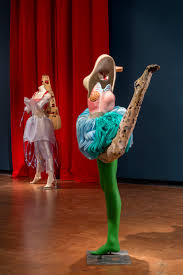
They’re also reflective of a narrative that is very specifically rooted in and imprinted upon the body. The mannequins are weathered, pitted, frequently fragmented, re-sectioned and up-ended – particularly in the Postmortem section of the show. One especially moving sculpture was a dismembered mannequin thrust forward on its breasts and remaining knee, headless, but bound with the intact and translucent plastic maquette of a complete female form on its back, as if to signify the complete woman that was its history, its abruptly discontinued narratve and aborted potential. The work reflects acutely a consciousness of the world’s violence – and against women in particular. Sundaram seemed to implicitly acknowledge this in a short film made in conjunction with the exhibition. “There was a violence here…. Where there is pain, there is also a history….”
But there is also the consciousnes that, regardless of the narrative, there is the possibility of “having delight and the pleasure of the surface … the making of something that will be a visual delight.” And there are many visual and sensual delights among the sculptural couture objects. I don’t think Sundaram consciously mimicked or imitated the work of any designer. But, perhaps not surprisingly, there are echoes of many of the greatest designers and couturiers. Given his focus on volumes and vessels, it was not surprising to me that one of his sculpture ensembles was vaguely reminiscent of Pierre Cardin. More than one evoked the spirit of André Courrèges, including a ‘bandage’-style dress (a bit of Hervé Leger in there, I suppose) constructed almost entirely of orthopedic supports, replete with spiraling ‘pillule’ hat – a quadruple spiral to outdo the papal ‘triple tiara.’
A pair of mannequins were actually titled, “Y S L”; at least one carried the Balenciaga ‘DNA’; and the Gaga-esque rubber “Tubing” dress could have only been approximated by Gauthier; but the designers who seemed most influential here were Issey Miyake and Junya Watanabe. In a darker vein, we can see affinities with the virtuosic Rick Owens (and his one-time protégé, Gareth Pugh). (E.g., “Cleopatra’s Trail,” 2011, or the sculpted rubber tunic with flaring dragon’s tail cape (“Liberty,” 2013) like a cresting wave that, with the mannequin’s exposed breast and upraised fist, hearkening back to Delacroix’s “Liberty Leading the People.” McQueen’s dark spirit is very much alive here in Sundaram’s “Snake Shell” (2011) – an armor of X-rays fit for a princess of darkness or possibly a scorpion. 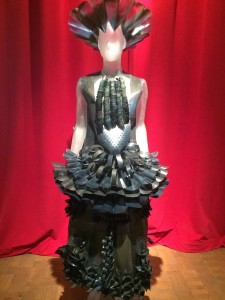
You have four more days – through Sunday, September 6th, to take in this amazing show of assemblage-as-souvenir-as-sculpture-as-couture – these surreal and exquisite cadavers that speak to us of an archaeology of memory, of unknowable pains, pleasures and places we might recapitulate in strange yet comprehensible forms.